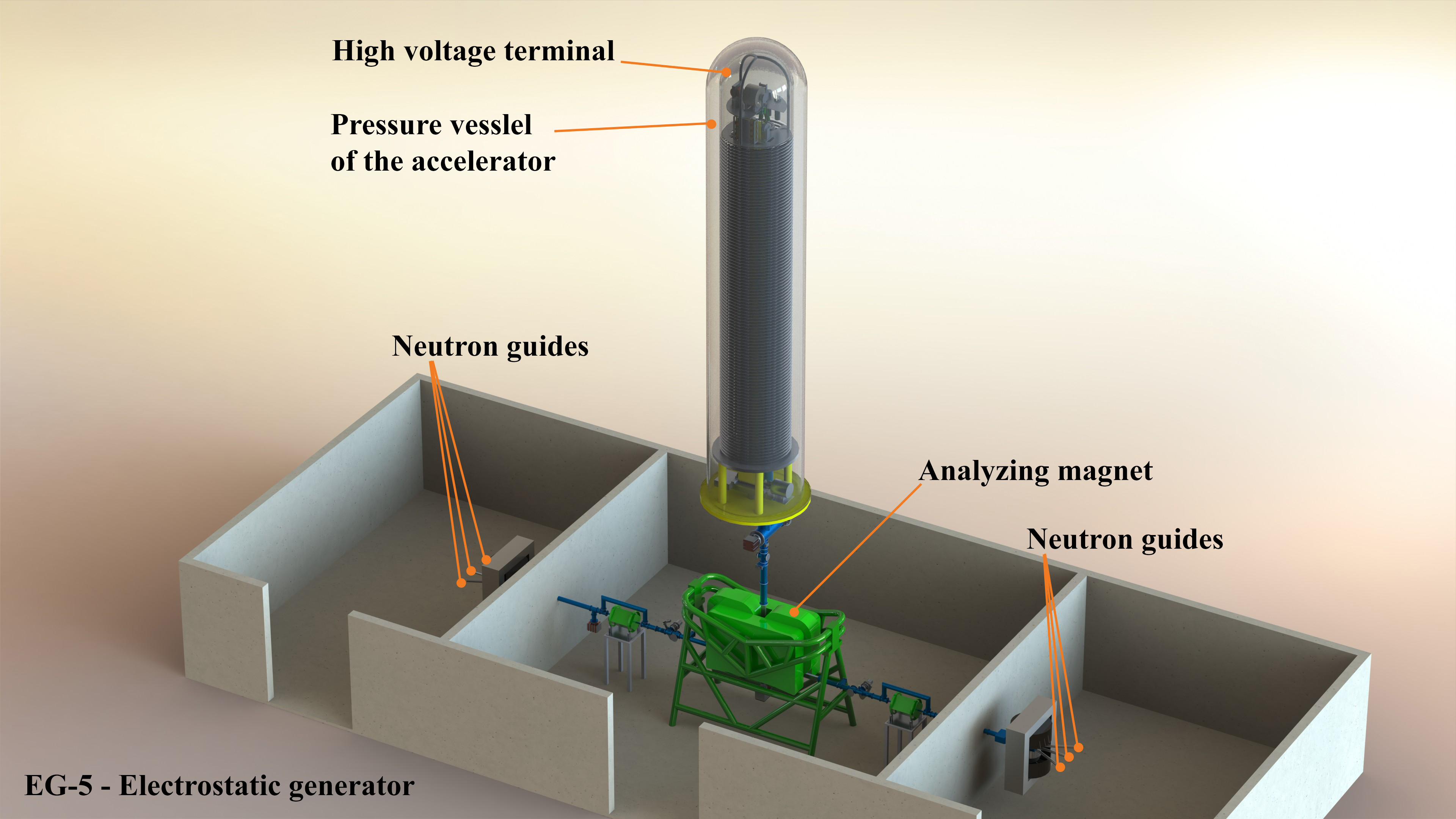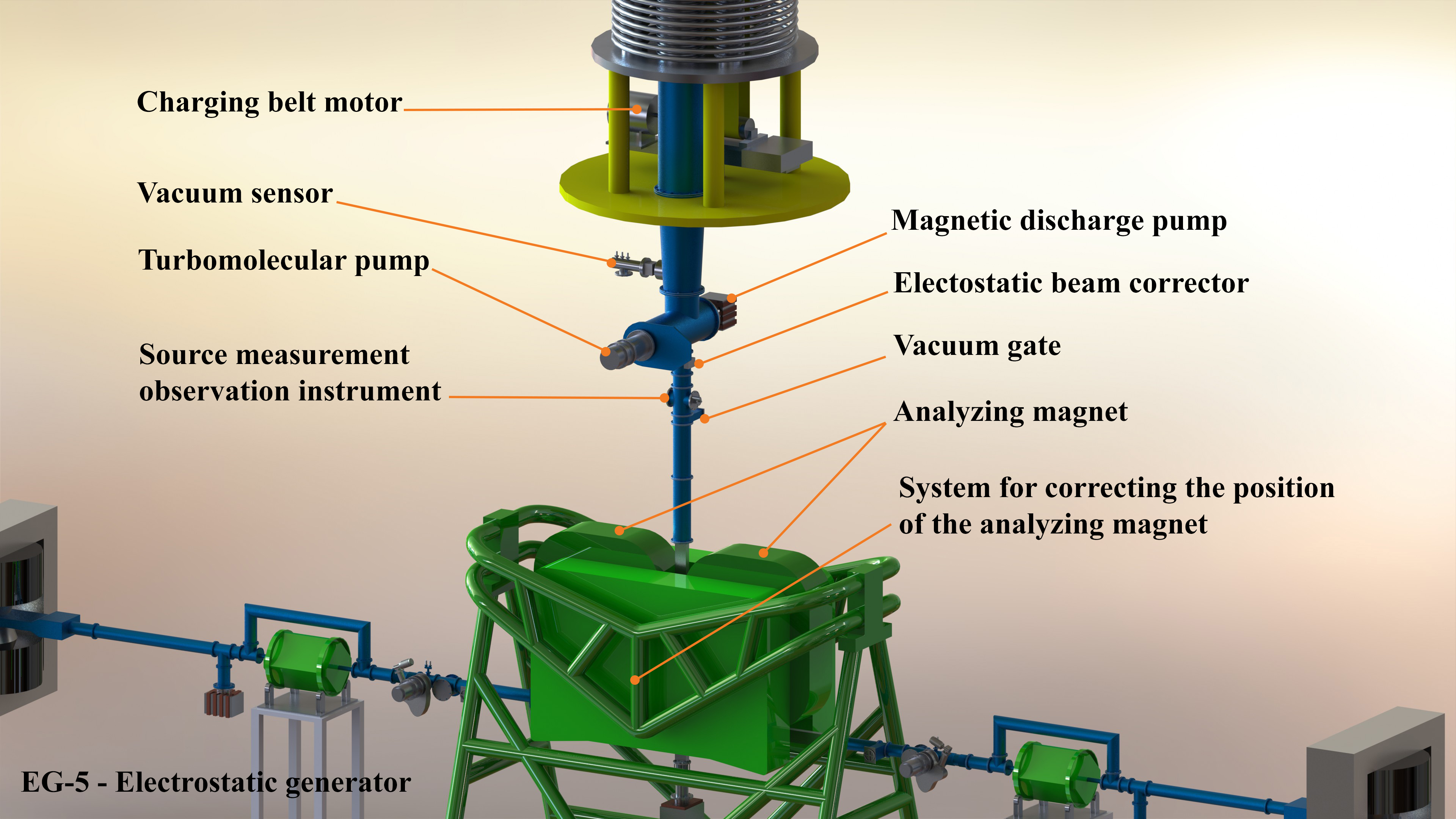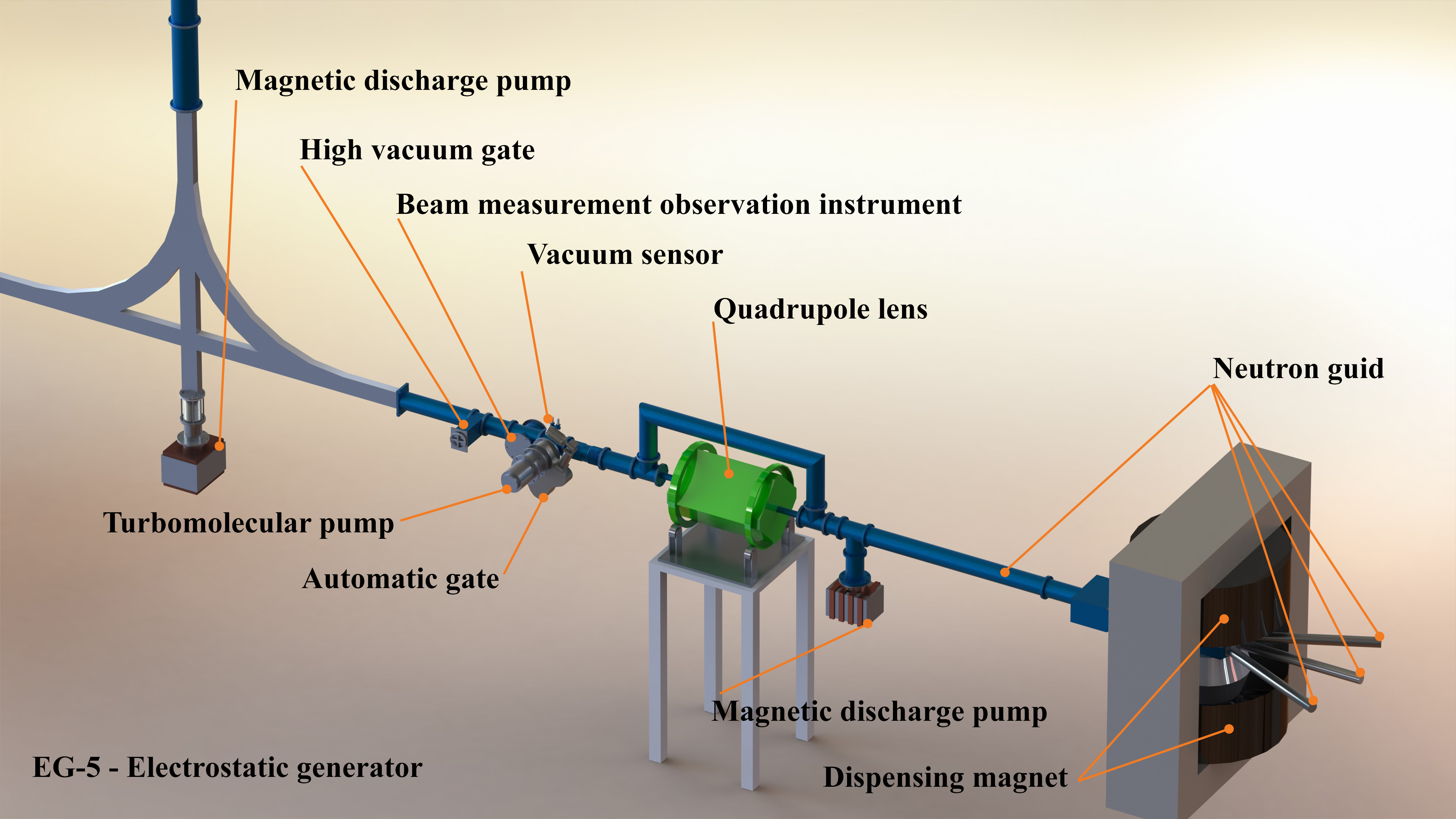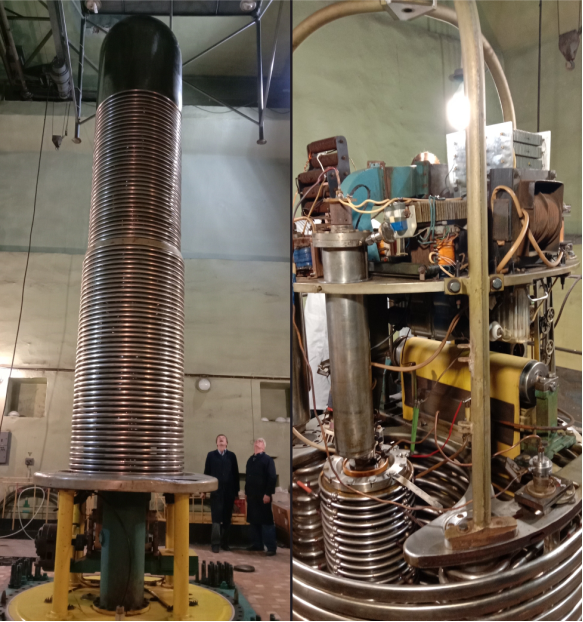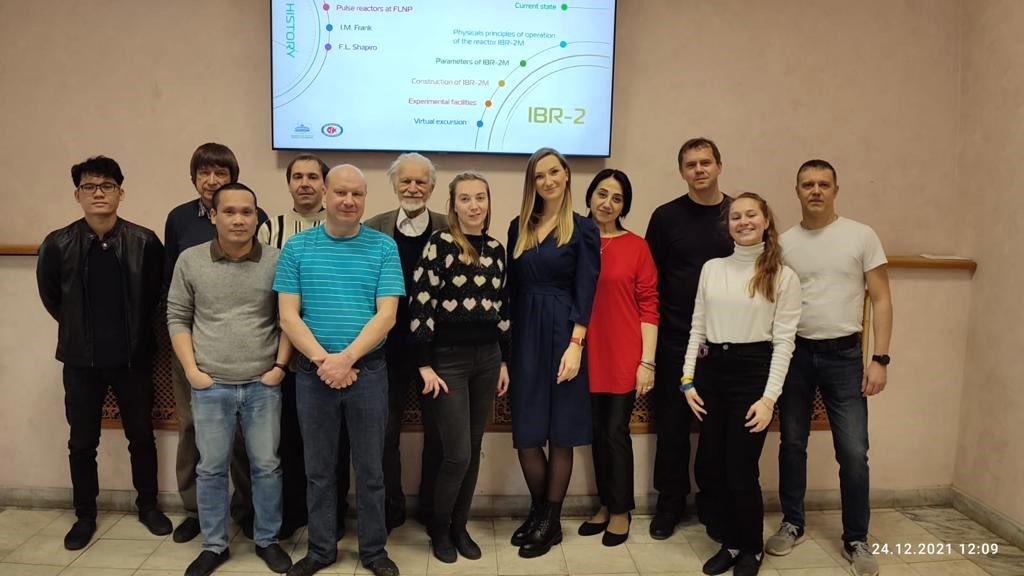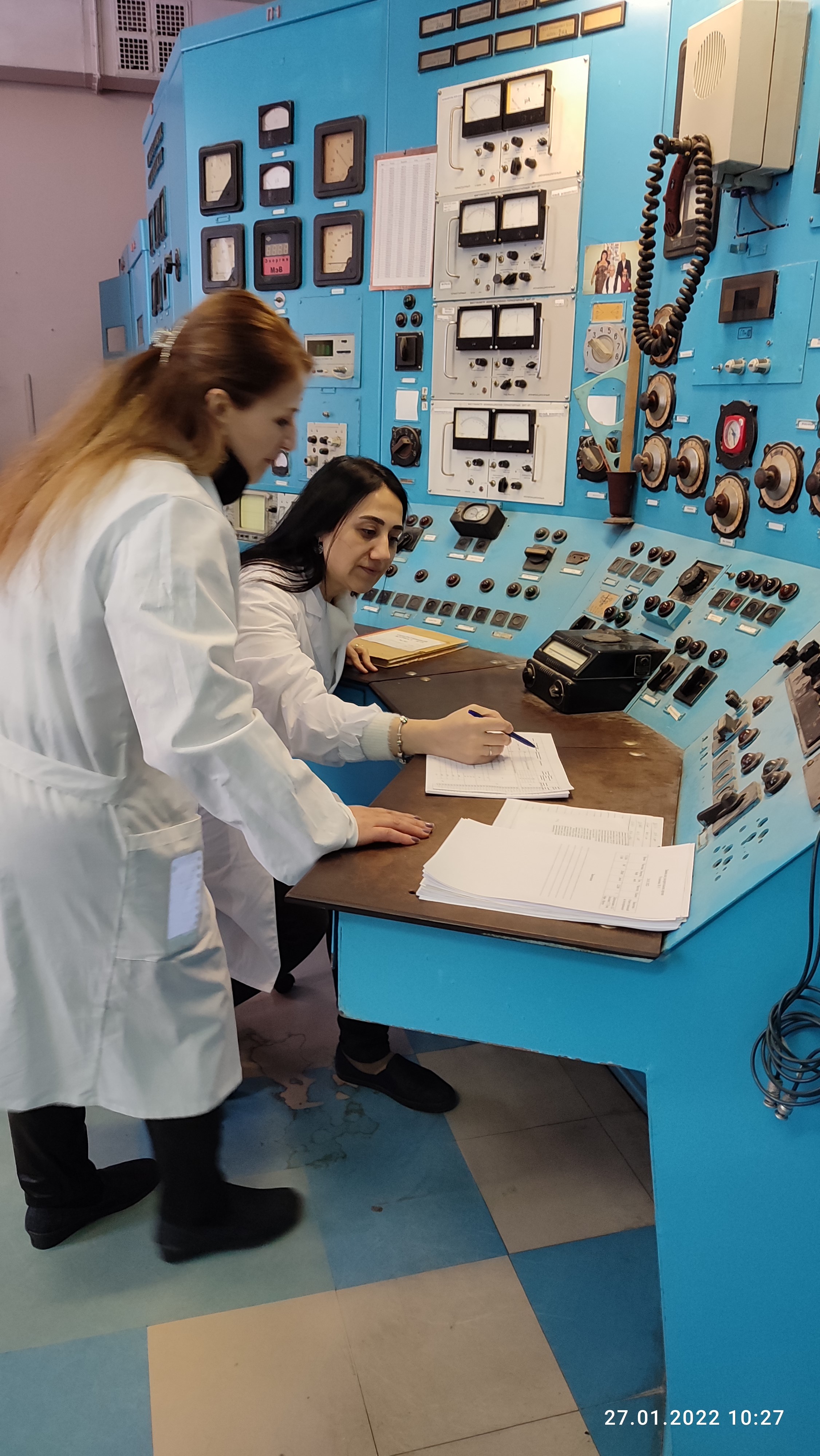Responsible for the facility:
Main research areas
Nuclear Physics
- Investigations of neutron-induced reactions with the emission of charged particles
Radiation materials science
- Investigation of the resistance to neutron and proton radiation Al2O3 – ZrO2 – Y2O3 - ceramics, promising for the production of radiation-resistant solenoids of superconducting NiTi alloys; high-entropy alloys, promising for the manufacture of the casing of the developed thermonuclear reactor;
- Unique research of the degradation of semiconductor heterojunctions of solar cells (SiO2/TiO2) under the cosmogenic radiation;
- Physical and chemical modification of materials using a high-energy ion beam, in particular, the development of a technology for conjugating materials with significantly different thermal expansion coefficients by producing helium or hydrogen porosity is underway (Poland - JINR Cooperation Project PPPB/120-26/1128/2022).
Radiation biology
- Investigation of radiation mutagenesis of rice crops.
Condensed matter physics
- Investigation of the elemental composition and depth profiles of metal-oxide ceramics.
Facility layout
Description of EG-5
The electrostatic accelerator (ESA) EG-5 developed on the basis of the Van de Graaff generator has been permanently operating at DNP FLNP JINR (Dubna) since 1965*. Currently, it is the only operating ESA at JINR. Due to the relative simplicity and reliability of the design and also characteristic of direct-action accelerators: the unique parameters of the accelerated ion beam (high energy stability (0.01%) at relatively high intensity), the EG-5 accelerator, having no alternative, is one of the most efficient and convenient nuclear physics instruments to meet a wide range of topical scientific issues in nuclear physics, condensed matter physics, biology, electronics, medicine and other fields.
Electrostatic accelerator EG-5
Main characteristics of the accelerator EG-5
Ion beam current range
0.01 - 10 µA
Ion beam energy range
1 MeV - 3 MeV
Energy resolution (H+, He+)
no worse than 15 keV
Charged particle flux (H+, He+)
1012 particles/s·cm−2
Neutron flux
5·107 particles /s·cm2
Maximum neutron energy
5.5±0.1 MeV (Deuteron current - 2-10 μA, deuteron energy - 2.5 MeV)
The uniqueness of the accelerator and the complex of spectrometers
Along with the experimental nuclear reactor and the IREN pulsed accelerator, the ESA EG-5 has its own unique niche in the complex of nuclear physics facilities of FLNP. The beams of high-energy particles obtained using EG-5 have the highest energy stability (±15 keV per 2 MeV) that allows to carry out unique investigations of the elemental composition of solids, including depth profiling, research of nuclear reactions using fast neutrons and so forth. The ESA EG-5 is a universal research instrument that allows to implement both research of elemental composition and physical, chemical and biological modification of objects of inanimate and living nature, respectively. In particular, there is a unique possibility of irradiating materials with hydrogen ions, helium and fast neutrons, the ability to develop structures with layer-by-layer variation in the phase and chemical composition using ion implantation in the surface layers of materials and to cause mutagenesis in biological objects.
The energy range up to 2.5 MeV - 4.1 MeV (after modernization) allows to simulate the radiation conditions of near space, the reactor core of nuclear reactors. The absence of slow neutrons in the spectrum of neutrons produced by the facility allows to carry out irradiation without inducing guided radioactivity that is extremely essential when studying unique samples such as cultural heritage sites.
Using the EG-5 facility on helium ion beams, unique non-destructive experimental studies of elemental depth profiles are carried out with a depth resolution of about 10 nanometers (RBS method). There is a unique opportunity to study layered structures. The sensitivity limit of the method allows, for example, to determine the content of impurities of heavy elements or to distinguish a substance in the form of a layer up to 1 nm thick. With complex use of non-destructive testing methods: Recoil proton methods (Elastic Recoil Detection, ERD), Nuclear Reaction Analysis (NRA), Particle Induced X-Ray Emission (PIXE), based on beam protons and helium ions with energies from 1 to 3.1 MeV make it possible to determine with high accuracy the elemental composition and deep distribution in the near-surface layer of all elements of the periodic table and their isotopes (including light hydrogen).
In 2022, the modernization of the main functional units of EG-5 will start with the replacement of the high-voltage tube that has lost its performance. Engineering and technical forces with the specialists from the "High Voltage Engineering Europa B.V." company have designed to replace it with a branded analogue with the subsequent adaptation of service equipment and the implementation of the recommendations of the supplier company regarding the technical conditions for the operation of the new tube. In parallel, work will begin on automating the control systems of the accelerator and upgrading the experimental equipment, including the installation of new instruments complementary to the current range of research methods.
On the basis of the restored accelerator in the med-term (2023-2026), a unique microbeam spectrometer, a nuclear microprobe, will be developed (as of 2021, there are only 2 units of such devices in the Russian Federation and the JINR Member States) that will allow to study the elemental composition from microscopic areas of the surface of physical objects, as well as the objects with a rough surface, to scan over areas, local irradiation of organelles of living cells. In addition to a high-precision microbeam spectrometer based on a neutron-producing target, several new facilities will be developed on the EG-5 beamlines in the next seven years, including an intense source of fast neutrons with neutron energies up to 16 MeV and a radiocarbon spectrometer.
In addition to modernization and expansion of the instrumental base of the accelerator complex, the laying of personnel potential for the next 20-30 years will be carried out. At present, a separate group "The EG-5 facility" has been established as part of the SINNI sector of DNP, staffed in addition to highly qualified specialists by active fellows - students from the Dubna University. Currently, they are trained in research methods and rules for operating the accelerator.
Modernization of EG-5 at JINR, where there are highly qualified specialists, good detecting equipment and valuable developments in the study of atomic nuclei using neutrons, will allow in the short term to implement a number of new, unique experiments on measuring the energy spectra and angular distributions of charged particles from the reactions (n, α ) and (n, p) / (α, n) and (p, n), integral and differential cross sections of the latter in the neutron energy range up to ~20 MeV, processes of fission of atomic nuclei using fast neutrons, activation analysis and others.
The use of microbeam spectrometers and, in fact, of ion beams as sources of ionizing radiation will allow to make significant progress in the development of new functional materials, devices and technologies for a range of areas of the economics, including high-tech healthcare technologies, technologies for the production of functional food products, included in the list of priority tasks of scientific and technical development of the Russian Federation. Nevertheless, the EG-5 modernization project should be considered rather as an important, yet an intermediate stage of great work. In order to successfully develop the areas discussed above within the framework of JINR and to take a leading position in the future, it is necessary to purchase an additional new modern electrostatic accelerator with energies up to 6 MeV in the future.
Main research areas
Nuclear Physics
- investigations of neutron-induced reactions with the emission of charged particles
In the future (1-2 years), after the modernization of the EG-5 facility, experimental work will be carried out in nuclear physics, including:
- investigation of MND and TKE in the reactions 235U(n,f), 238U(n,f), 237Np(n,f) in the neutron energy range 1-5 MeV (EG-5) in a geometry with a low efficiency of registration of MND;
- investigation of the MND multiplicity in the reactions 235U(n,f), 238U(n,f), 237Np(n,f) on fast neutrons in a geometry with a high efficiency of MND detection;
- investigation of the process in the reaction 239Pu(nres,f);
- investigation of the counting characteristics of the fission chamber in current and noise (Kemmbell) modes as applied to the measurement of the neutron lifetime
Radiation materials science
- Investigation of the resistance to neutron and proton radiations Al2O3 - ZrO2 - Y2O3 - ceramics, promising for the production of radiation-resistant solenoids of superconducting NiTi alloys; high-entropy alloys, promising for the manufacture of the developed thermonuclear reactor vessel,
- Unique investigations of the degradation of semiconductor heterojunctions of solar cells (SiO2/TiO2) under cosmogenic radiation,
- Physical and chemical modification of materials using a beam of high-energy ions, in particular, the development of a technology for conjugation of materials with significantly different thermal expansion coefficients by creating helium or hydrogen porosity is underway (Poland - JINR Cooperation Project PPPB/120-26/1128/2022).
Radiation biology
- Investigation of radiation mutagenesis of rice crops. On the example of varieties "Cheese Suluy", "AyKerim" and "Leader" in cooperation with the Kazakh Research Institute of Rice named after Zhakhaev, the possibility of obtaining a drought-resistant rice variety using neutron and proton irradiation is investigated.
Condensed Matter Physics:
- Investigation of the elemental composition and depth profiles of metal-oxide ceramics based on ZrO2, Al2O3, CuO, ZnO, SnO2, high-entropy metal alloys, borides, nitrides, semiconductors based on Si, SiO2, ZnO2, GaAS, Multilayer semiconductor architectures of the type (TiO2/ SiO2/Si, SiO2/TiO2/Si, GaAs, etc. - Metallic (Fe, Cu) and (ZrO2,) solid solutions, nanopowder and micropowder systems (diamonds, sphalerites, perovskites, ferrites), (techniques are currently being developed).
Helium ion beams are used for unique non-destructive experimental studies of elemental depth profiles with a depth resolution of about 10 nanometers (RBS method). There is a unique opportunity to study layered structures. The sensitivity limit of the method is 1015 at. × cm-2 that allows, for example, to determine the impurity content of heavy elements in an amount of 0.001 at.% or to recognize a substance in the form of a layer up to 1 nm thick. With complex use of non-destructive testing methods: Elastic Recoil Detection (ERD), Nuclear Reaction Analysis (NRA), Particle Induced X-Ray Emission (PIXE), based on proton beams and helium ions with energies from 1 to 3.1 MeV it will be possible to determine with high accuracy the elemental composition and deep distribution in the near-surface layer of all elements of the periodic table and their isotopes (including light hydrogen).
In the future (1-2 years):
Radioisotope dating (isotopes 14С and 18О)
Determination of the quantitative composition of light elements in inelastic interaction with matter of fast neutron fluxes.
Sample environment
The EG-5 measuring complex includes:
- A module of ion-beam spectrometers (RBS, ERD and PIXE. NR), equipped with two α detectors and a γ detector;
- Gas neutron-producing target with a neutron monitor and an instrument complex;
- Chamber for irradiation of samples;
- Facility for the study of helium porosity (joint experiment with FLNR);
- Facility for determining the quantitative composition of light elements in inelastic interaction with matter of fast neutron fluxes (in the process of debugging);
- Sample cells for environment interfaces: solid/liquid, air/liquid, air/solid;
- Electrochemical cell of a sample;
- Thermostat: (-20 ÷ +180) °С;
- Anti-vibration sampling bench;
- Potentiostat/galvanostat (with impedance spectroscopy option) Bi-logic SP-20;
- Langmuir-Blodgett bathtub LLC "Microtestmachines" LT-2211.
Publications
Electrostatic accelerator EG-5: opportunities and prospects
- Kulik, Z. Surowiec, W. Rzodkiewicz, J. Filiks, A. Drozdziel, „Effect of N+2 ion implantation and thermal annealing on near-surface layers of implanted GaAs”, Acta Physica Polonica A 128 (5), 918-922 (2015)
- Kulik, D. Kołodyńska, A.P. Kobzev, F.F. Komarov, Z. Hubicki, K. Pyszniak, “Chemical composition of native oxides on noble gases implanted GaAs”, Thin Solid Films 616, 55-63 (2016)
- Horodek, J. Dryzek, A.G. Kobets, M. Kulik, V.I. Lokhmatov, I.N. Meshkov, O.S. Orlov, V. Pavlov, A.Yu. Rudakov, A.A. Sidorin, K. Siemek and S.L. Yakovenko, “Slow Positron Beam Studies of the Stainless Steel Surface Exposed to Sandblasting” Acta Physica Polonica A, 125 (3) 714-717 (2014)
- Horodek, K. Siemek, A.G. Kobets, M. Kulik, I.N. Meshkov, “Positron beam and RBS studies of thermally grown oxide films on stainless steel grade 304”, Applied Surface Science, 333 96–103 (2015)
- Rzodkiewicz, M. Kulik, A. Pans, A.P. Kobzev, Nuclear and Optical Analyses of MOS Devices, ACTA PHYSICA POLONICA A Volume: 123 (5) 851-853 (2013)
- Vasilenko, A. Kirillov, A. Islamov, A. Doroshkevich. (2021). Study of hierarchical structure of fossil coals by small-angle scattering of thermal neutrons // Fuel 292. 120304. 10.1016/j.ceramint.2020.09.151(Q1, IF= 5.578).
- AsifA. Nabiyev, AndrzejOlejniczak, AkhmedKh. Islamov, AndrzejPawlukojc, OleksandrI. Ivankov, MariaBalasoiu, AlexanderZhigunov, MusaA. Nuriyev, FovziM. Guliyev, DmytroV. Soloviov, AidosK. Azhibekov, AlexanderS. Doroshkevich, OlgaYu. Ivanshina, AlexanderI. Kuklin. (2021). CompositeFilmsofHDPEwithSiO2 and ZrO2 Nanoparticles // Nanomaterials. 11(10), 2673; 3390/nano11102673 (Q1, IF=5,07).
- Danilenko Igor, Gorban Oksana, Shylo Artem, Volkova Galina, Yaremov Pavlo, Konstantinova Tetyana, Doroshkevych Oleksandr, Lyubchyk Andriy.(2021).Humidity to electricity converter based on oxide nanoparticles. JOURNAL OF MATERIALS SCIENCE. 1007/s10853-021-06657-9 (Q1, 4.22)
- B. Asgerov, A. I. Beskrovnyy, N. V. Doroshkevich, C. Mita, D. M. Mardare, D. Chicea, D. Lazar, A. A. Tatarinova, V. A. Alexandrov, S. I. Lyubchyk, S. B. Lyubchyk, A. I. Lyubchyk, A. S. Doroshkevich. (2022). Martensitic phase transition in yttrium-stabilized ZrO2 nanopowders by adsorption of water // Nanomaterials 12. 435. 10.3390/nano12030435 (Q1, 4.03).
- Maletsky A.V., Belichko D.R., Konstantinova T.E., Volkova G.K., Doroshkevich A.S., Lakusta M.V., Lyubchyk A.I., Burkhovetskiy V.V., Aleksandrov V.A., Mardare D., Mita C., Chicea D, L.H.Khiem. (2021). STRUCTUREFORMATIONANDPROPERTIESOFCERAMICSBASEDONθ-ALUMINIUMOXIDEDOPEDWITHSTABILIZEDZIRCONIUMDIOXIDE" // CeramicsInternational1016/j.ceramint.2021.03.286(Q1, IF=3,83).
- StanculescuAnca, SocolMarcela, RasogaOana, BreazuCarmen, PredaNicoleta, FlorinStanculescu, GabrielSocol, LoredanaVacareanu, MihaelaGirtan, AlexanderS. Doroshkevich. (2021). Arylenevinylene oligomers based heterostructures on flexible AZO electrode for electronic applications // Materials 14. 10.3390/ma14247688. (Q1, 3.62).
- AlisaA. Tatarinova, А.S. Doroshkevich, O.YuIvanshina, O.S. Pestov, M. BalasoiuandP.P. Gladyshev. (2021). Development of siloxane coating with oxide fillers for kesteritic (CZTS) photovoltaic systems. // Energies 14. Issue 8. 2142- 3390/en14082142(Q2, IF=2,7).
- ArtemShylo, IgorDanilenko, OksanaGorban, OleksandrDoroshkevich, IgorNosolev, TetyanaKonstantinova, AndriyLyubchyk. (2022). Hydrated zirconia nanoparticles as media for electrical charge accumulation // J Nanopart Res 24:18 1007/s11051-022-05407-5. (Q2, IF=2.53).
- D.R.Belichko, T.E.Konstantinova, A.V.Maletsky, G.K.Volkovaa, A.S.Doroshkevich, M.V.Lakusta, M.Kulik, A.A.Tatarinova, D.Mardare, C.Mita, N.Corneie. (2020) InfluenceofhafniumoxideonthestructureandpropertiesofpowdersandceramicsoftheYSZ–HfO2composition. // Ceramics International 1016/j.ceramint.2020.09.151. (Q1, IF=3,83).
- Artem Shylo, Aleksandr Doroshkevich, Andriy Lyubchyk, Yuri Bacherikov,·Maria Balasoiu, Tetyana Konstantinova. (2021). Electrophysical properties of hydrated porous dispersed system based on Zirconia nanopowders // Applied Nanoscience. 1007/s13204-020-01471-2. (IF=3.2).
- DoroshkevichA., BurkhovetskiyV.V., NabiyevAsif , Vasilenko, T., IslamovAkhmed, CrausM.L. andels. (2019). Self-organization processes in nanopowder dispersed system based on zirconia under pressure action. Results in Physics. 10.1016/j.rinp.2019.102809.(IF=3.5).
- Tran Van Phuc, M. Kulik, A. P. Kobzev, Le Hong Khiem, Study of MOS structures using nuclear analytical methods, Communications in Physics, Vol. 27, No. 4 (2017), pp. 279-289. https://doi.org/10.15625/0868-3166/27/4/10825
- V. Phuc, M. Kulik, A. P. Kobzev, L. H. Khiem, Study of elemental depth distribution in the material TiO2/SiO2/Si by Rutherford Backscattering Spectrometry (RBS), Communications in Physics, Vol. 29, No. 3SI (2019), pp. 393-400. http://dx.doi.org/10.15625/0868-3166/29/3/14328
- T.V. Phuc, M. Kulik, D. Kołodyńska, L.H. Khiem, P.L. Tuan, J. Zuk, M. Turek, Investigations of elemental depth distribution and chemical compositions in the TiO2/SiO2/Si structures after ion irradiation, Surface & Coatings Technology, 387 (2020), 125494. http://doi.org/10.1016/j.surfcoat.2020.125494 (Q1, IF=4.16)
- L. Tuan, M. Kulik, J. Nowicka-Scheibe, J. Żuk, P. Horodek, L.H. Khiem, T.V. Phuc, Nguyen Ngoc Anh, M. Turek, Investigations of chemical and atomic composition of native oxide layers covering SI GaAs implanted with Xe ions, Surface and Coatings Technology, Volume 394, 25 July (2020), 12587. http://dx.doi.org/10.1016/j.surfcoat.2020.125871 (Q1, IF=4.1)
- T.V. Phuc, Miroslaw Kulik, Afag Madadzada, Le Hong Khiem, Marcin Turek, Dorota Kołodyńska, Phan Luong Tuan, Nguyen Ngoc Anh, Mai Quynh Anh, Nguyen Van Tiep, Krzysztof Siemek, Variation of TiO2/SiO2 mixed layers induced by Xe+ ion irradiation with energies from 100 to 250 keV, Materials Science and Engineering: B, Volume 277, (2022), 115566. https://doi.org/10.1016/j.mseb.2021.115566 (Q1, IF=4.05).
*Testing mode
